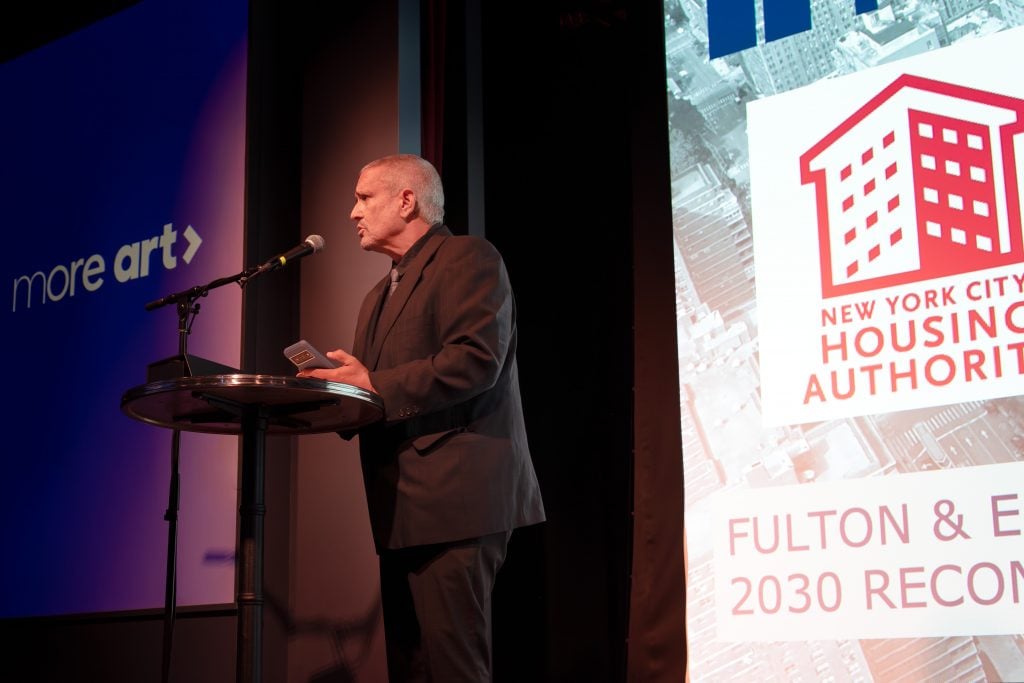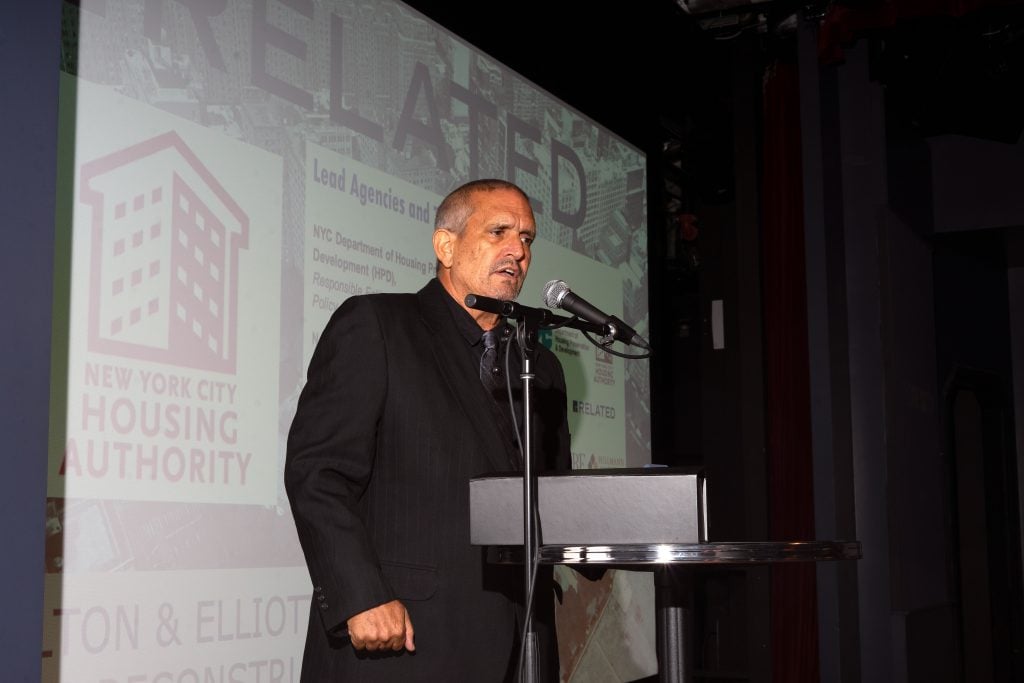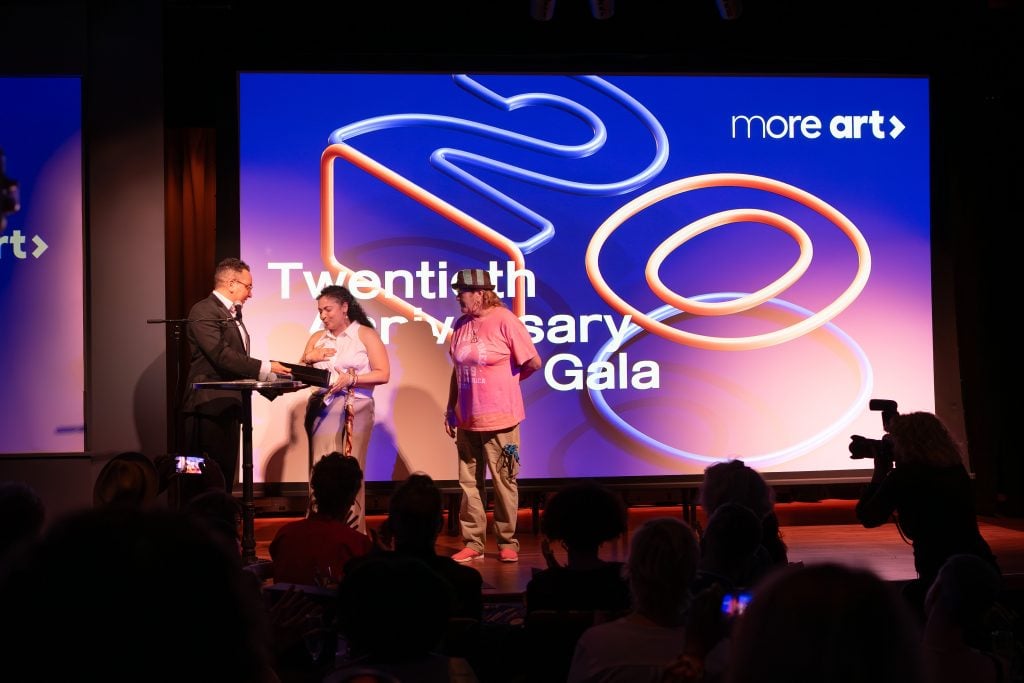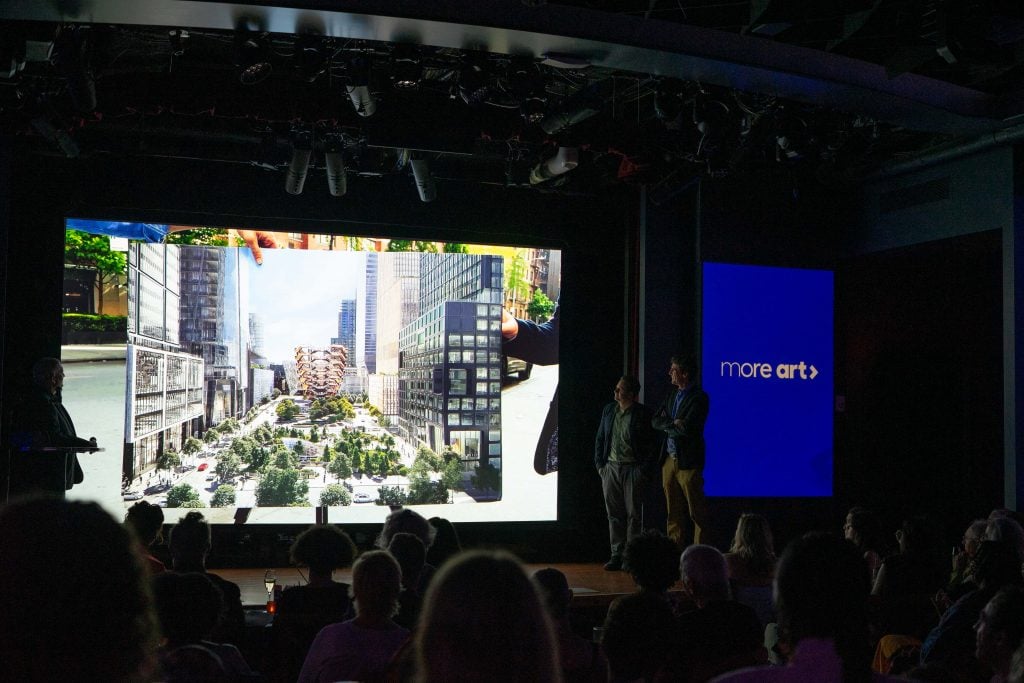Law & Politics
Activist Group the Yes Men Crashes an Art Gala to Call Out Gentrification
The event was the latest in the group's long line of actions.

The event was the latest in the group's long line of actions.

Adam Schrader

At the 20th anniversary gala for nonprofit More Art last week, representatives from Related Companies, the developer behind the Hudson Yards neighborhood in New York, stepped onstage. The catch? They weren’t the company’s real executives, but members of performance art group the Yes Men, arriving to blast the planned real-life demolition of the Fulton and Elliott-Chelsea Houses, two public housing projects under New York City Housing Authority (NYCHA) management.
The performers received a convincing introduction from More Art curator Dylan Gauthier, who touted the nonprofit’s efforts to champion works by artists in communities impacted by displacement and gentrification.
“We’re delighted to announce a partnership with More Art that will make More Art the beneficiary and anchor tenant of one of their new spaces,” Gauthier joked. He then invited Jacques Servin of the Yes Men, masquerading as the head of public relations for Related Companies, onstage.
(In a video interview after the performance, Servin credited some of the performance’s success to Gauthier’s introduction: “People were freaked out. A lot of people believed it because, what, Dylan’s going to lie to them?”)

Jacques Servin of the Yes Men at the More Art Gala in character as an executive with Related Companies, the developer of Hudson Yards. Photo: Adam Schrader.
After taking the stage to mild applause and a couple of boos from tipped-off audience members, Servin—in character—announced Related Companies’ real-life plans for the Fulton and Chelsea Elliot Houses.
“We’re working to improve the conditions of, not only the residents, but all of those who live in Chelsea and all of New York City,” Servin said. “Just as Hudson Yards replaced what was previously a mere train depot, Chelsea Yards will replace the Fulton and Chelsea Elliot Houses with an income-diverse and income-exclusive and fully supportive community of stores, business suites, diverse options, and art galleries.”
Some audience members seemed quick to catch on, with scattered laughs heard throughout the audience.
Videos created by comedy podcasting duo the Good Liars, which had interviewed real New Yorkers about the development plans, were then aired. “We’re going to try to sell the new development to the people of Chelsea. I think it’s going to work because everyone wants a new building filled with rich people,” the Good Liars said before the videos played.

Political comedy duo Jason Selvig and Davram Stiefler of the Good Liars at the More Art Gala. Photo: Adam Schrader.
When Servin revealed himself as part of the Yes Men, he discussed Related Companies’ real-life plans, noting that the actual survey of residents never mentioned words like “demolition” or plans to change the program from Section 9 housing.
In truth, the sites will be reconstructed as mixed-use and mixed-income buildings under Section 8 public housing programs. While the buildings will still include apartments for low-income families, the change of classification has been blasted by critics.
Under the U.S. Housing Act of 1937, Section 8 provides rental assistance through vouchers for private market housing, while Section 9 allows for the funding and maintenance of housing developments owned by public housing authorities, like NYCHA. Servin, in an interview, called Section 8 housing “far inferior.” But NYCHA, in recent years, has received a laundry list of criticism for poor maintenance of its buildings including health and safety issues for its tenants.
Still, critics including the organization Save Section 9 consider it the most effective type of housing program with the strongest rights for tenants, even if disinvestment in it has led to deteriorating living conditions. They also argue that Section 9 housing is more affordable for the lowest of low-income households, unlike Section 8 programs. Save Section 9 representatives at the gala listed politicians they blame for the decision, such as controversial New York City Mayor Eric Adams, Rep. Jerrold Nadler, and other Democratic leaders.

Ramona Ferreyra, founder of the advocacy group Save Section 9, and Jacqueline Lara, a resident of the Fulton and Elliott-Chelsea Houses, are pictured onstage at the More Art gala. Photo: Adam Schrader.
For Servin, Related Companies is a ripe target for the Yes Men’s brand of activism. In public meeting presentations, the organization has claimed that 30 percent of displaced residents would return to the site within three years, with the remaining 70 percent of residents returning within six years. It’s not clear how that would be possible as the number of apartments will be slimmed down to just 875 permanently affordable housing units from the current 2,055.
“They are going to demolish [multiple] buildings of venerable, reliable, very New York public housing,” Servin said. “And I knew most people would be horrified to learn that they were going to evict thousands of tenants who needed housing more than anyone else.”

The Good Liars playing a video they created as part of a performance with the Yes Men at the More Art Gala. Photo: Adam Schrader.
For more than two decades, the Yes Men, formed by Servin and Igor Vamos, have been using performance and satire to interrogate social and political issues. Their members have impersonated representatives and created spoof websites of companies from McDonald’s to ExxonMobil in their bid to expose the harms that corporations pose to individuals. The group’s many hoaxes, which have confronted issues including climate change, economic policies, and environmental despoliation, have been documented across three films.
Public housing concerns have come into view for the Yes Men, notably when the activists took aim at the U.S. Department of Housing and Urban Development’s plan to demolish public housing in New Orleans purportedly damaged by Hurricane Katrina. The performance, which saw a Yes Men member posing as a HUD spokesperson at a conference in the city, was captured in the 2009 film The Yes Men Fix the World.
Servin suggested that getting rid of Section 9 housing in New York could spell doom for elected officials who “don’t get in line with what people actually need” and “improve what’s there, expand what’s there, and give up this idea of giving everything to the developers.”
“If you could get five percent of the people who hate Hudson Yards and are appalled at the idea of demolishing Section 9 housing to activate a bit and start calling these people,” he added, “and maybe one percent of them could show up at their houses and protest and make sure they hear, that might make a difference.”

Mona Ghasemi, the president of More Art, laughing at a surprise performance by the Yes Men at the More Art Gala. Photo: Adam Schrader.
Servin sees the Yes Men’s work as operating at the intersection of activism and art. He pointed to other performance artists such as Sacha Baron Cohen of Borat fame and TikTok stars Chad Kroeger and JT Parr, known for crashing local government meetings as surfer bros clueless to heated political issues, as similarly using deceit as a medium for artistic activism.
“They’re using this surprise element, this infiltration, to get people to reveal who they are, which is a little different from what we do,” Servin said. “People say things that are quite revealing. It’s about using the techniques of performance art for a political reason. I don’t know if that turns it from Jackass into activism. But I think it does.”
While the group worked with More Art for this particular performance, the group doesn’t always have the approval of the organization it is targeting. The Yes Men have been twice detained by security; the U.S. Chamber of Commerce has also sued them. Servin said any blowback from the Related Companies stunt would be “a godsend” because it would mean they were engaging with the public. “Their best bet, unfortunately, is to ignore it. And, unfortunately, they know that,” he said.
“The jokes, hopefully, were funny,” he added of the performance itself. “But the reality it’s pointing to is not very funny. It’s like a laugh that is very uncomfortable. I think there’s a word for that in French.”